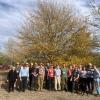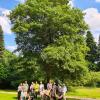Editor's Picks
Plant Focus
Presentation given at the XX International Botanical Conference, Madrid, Spain, July 21–27, 2024.
Authors:
Francisco I. Pugnaire1, Christian Kindler1, Esteban Manrique3
Affiliations:
1. Estación Experimental de Zonas Áridas, Consejo Superior de Investigaciones Científicas, Almería, Spain
2. Real Jardín Botánico, Consejo Superior de Investigaciones Científicas, Madrid, Spain
Abstract:
Seed germination is a critical step in plant establishment and is influenced by both abiotic and biotic factors. Humidity, radiation, and temperature generally determine germination onset, which is also influenced by the microbiota. Germination rate depends therefore on the interaction between microbes hosted by the seed, soil microbes and environmental clues. Over time, plants selected specific sets of microbes and evolved together in response to local conditions. We looked at the role of soil microorganisms on holm oak (Quercus ilex L.) germination, and specifically whether soil microbes from its own habitat enhanced germination more than soil microbes from other habitats, testing whether the home-field advantage hypothesis (HFA) reported for litter decomposition applies to seed germination. We used Q. ilex seeds from different provenances sowed with a factorial design on sterilised soil from different habitats, and added soil extracts with the microbiome from the same soils. The objective was to tell apart effects from soil and microorganisms. We recorded seed germination daily for about 2 months. Overall, germination rate of Q. ilex seeds from Somiedo (N Spain) was higher than seeds from Ronda (S Spain). Soil extracts from Somiedo enhanced seed germination more than other extracts, pointing to the soil microbial community as the factor controlling seed germination. There was a significant difference in HFA between the two localities, being positive in Ronda and negative in Somiedo, suggesting stronger coevolution between plants and soil microbes under harsh than under mild environmental conditions. Our results evidence that soil community structure and diversity critically contribute to Q. ilex germination, all else being equal.
















